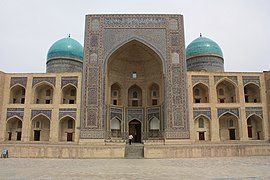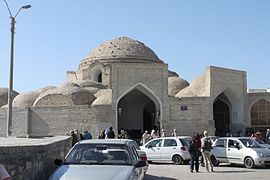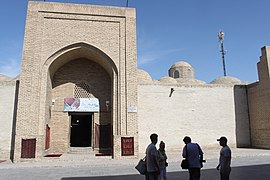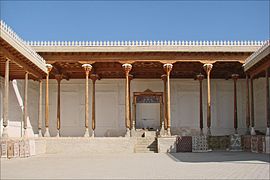Historic center of Buxoro
| Historic center of Buxoro | |
|---|---|
|
UNESCO world heritage |
|
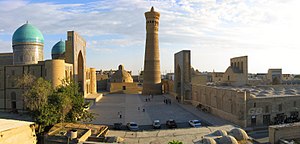
|
|
| Poi Kalon ensemble in the historic center of Buxoro. |
|
| National territory: |
|
| Type: | Culture |
| Criteria : | (ii) (iv) (vi) |
| Reference No .: | 602 |
| UNESCO region : | Asia and Pacific |
| History of enrollment | |
| Enrollment: | 1993 (session 17) |
| Extension: | 2016 |
The historical center of Buxoro is a UNESCO- listed World Heritage Site in the Central Asian state of Uzbekistan . The world heritage site includes the historic city center ( Schahrestan ) of the city of Buxoro (Bukhara).
background
Buxoro is a 2000-year-old city on the Silk Road . At the time of the Sassanids , Buxoro was one of the prosperous Sogdian city-states that controlled trade on the Silk Road. After the Arab conquest and Islamization of Central Asia, Buxoro, the capital of the Samanid Empire, became a flourishing center of trade and handicrafts and a spiritual pole of Islam . After the end of the Samanid rule, Buxoro lost its political importance under the sovereignty of the Karakhanids , but continued to flourish in culture. In 1220 the city was conquered by Genghis Khan's troops and largely destroyed, another Mongolian conquest of the rebuilt city came in 1370 by Timur . Under the Scheibanids , Buxoro became the capital of the Uzbek Khanate in 1533 , which has since been referred to as the "Khanate of Bukhara". In 1785, the khanate was transferred to the Emirate of Bukhara , which came under Russian rule in 1868, but formally continued to exist until it was occupied by the Red Army during the Russian civil war in 1920.
Buxoro is one of the best examples of a medieval Islamic city in Central Asia, the urban structure of which has remained largely intact. With the exception of a few remains from the time before the Mongol invasions under Genghis Khan and under Timur, the old town primarily bears witness to the town planning and architecture of the Scheibanid period since the early 16th century.
registration
In 1991 the World Heritage Committee postponed a decision to include the historic center of Buxoro on the UNESCO World Heritage List. In 1993, the entry in the 17th session of the World Heritage Committee was promised. It was the second World Heritage Site in Uzbekistan and the first after the country gained independence from the Soviet Union . The only world heritage site in Uzbekistan up to then, Ichan Qalʼа , was included in the UNESCO world heritage during the times of the Soviet Union.
Since the site was on the tentative list that had been submitted by the Soviet Union, the Republic of Uzbekistan was asked to submit its own tentative list. Uzbekistan submitted this in October 1994, whereupon the World Heritage Committee confirmed the entry of the historic center of Buxoro on the UNESCO World Heritage List.
In the justification for the entry it is summarized after a list of important buildings:
"However, the real meaning of Buxoro does not lie in the individual buildings, but in the overall image of the city, which shows a high and consistent level of urban planning and architecture that began with the Scheibanid dynasty."
The entry was made on the basis of criteria (ii), (iv) and (vi).
“(Ii): The example of Buxoro with regard to its urban planning system and structures had a profound influence on the development and planning of cities in a large area of Central Asia.
(iv): Buxoro is the most complete and untouched example of a medieval Central Asian city that has retained its urban fabric to this day.
(vi): Between the 9th and 16th centuries, Buxoro was the largest center of Islamic theology, especially Sufism , in the Middle East with over two hundred mosques and more than a hundred madrasas . "
At the time of registration, the heritage site covered an area of 200 hectares . It was surrounded by a buffer zone with an area of 275 hectares. In 2016, the protection area was enlarged, it now has an area of 216 ha, the buffer zone of 339 ha. In addition to minor changes in the demarcation, in which individual blocks of houses were removed from the protection area, the protection area was mainly in the west around the Samanid area - Recreational parks expanded with the Samanid Mausoleum , the Chashmai Ayyub Mausoleum and a pond.
Buildings
Even if individual buildings were not decisive for registration as a World Heritage Site, but the overall image of the city, the following individual buildings and building ensembles are particularly highlighted in chronological order in the summary of the decision on registration.
The oldest surviving structures in the historical center of Buxoro date from the Samanid period in the 9th / 10th. Century. These include the originally preserved Samanid mausoleum and the Mag'oki Attori mosque, which has been rebuilt several times over the centuries .
Under the Qarakhanids in the 12th century, the Kalon Minaret was built , and the Mag'oki Attori Mosque was rebuilt and given a new south facade. The Chashmai Ayyub mausoleum , which is often also attributed to the Qarakhanids, probably goes back to the Timurids of the 14th century. The most important building from the Timurid period is the Ulug'bek Madrasa from the beginning of the 15th century.
Under the Scheibanids in the 16th century, the Poi-Kalon ensemble was built around the Kalon minaret , in which the Kalon Mosque (1514) and the Mir Arab Madrasa (1536/37) face each other in the Kosch principle . The Qo'sh madrasa , which consists of the Modari Khan Madrasa (1567) and the Abdullah Khan Madrasa (1590), even bears this principle of arrangement in its name. In 1565, the Koʻkaldosh Madrasa, the oldest component of the later Labi Hovuz ensemble, was built .
The domed bazaar buildings of Buxoro, including the domed bazaars Toqi Zargaron , Toqi Sarrofon and Toqi Telpak Furushon as well as the shopping arcades Tim Bazzazan and Tim Abdullah Khan , also mainly date from the Scheibanid period . At the end of the 16th century, the Hodscha Gaukuschan ensemble with madrasa, mosque and minaret was built.
Under the ruling in the 17th and 18th centuries Dschaniden was Labi-Hovuz ensemble created with its clustered around a water basin structures. The Nodir-Devonbegi-Chanaqa (1620) and the Nodir-Devonbegi-Madrasa (1623) were newly built and the existing Ko'kaldosh-Madrasa was incorporated into the ensemble. In 1637 the Mag'oki Kurpa Mosque was built, in 1652 the Abdulaziz Khan Madrasa was juxtaposed with the Ulugbek Madrasa in accordance with the Kosch principle. Most of the surviving buildings of the Ark Citadel date from the 18th century , including the mosque from 1712 and the ruler's palace with throne room, as well as the Bolo Hovuz Mosque, also built opposite the citadel in 1712 .
Web links
- Historical center of Buxoro on the UNESCO World Heritage Center website ( English and French ).
- Bukhara on UNESCO's Silk Road website
Individual evidence
- ^ World Heritage Committee: Decision: CONF 002 XV. In: whc.unesco.org. December 12, 1991, accessed November 15, 2016 .
- ↑ World Heritage Committee: Decision: CONF 002 XI.2. In: whc.unesco.org. February 4, 1994, accessed November 15, 2016 .
- ^ World Heritage Committee: Decision: CONF 003 XI.1-4. In: whc.unesco.org. January 31, 1995, accessed November 15, 2016 .
- ↑ a b c World Heritage Committee: Historic Center of Bukhara. In: whc.unesco.org. UNESCO, accessed on November 14, 2016 .
- ^ World Heritage Committee: Decision: 40 COM 8B.41. In: whc.unesco.org. June 10, 2016, accessed November 15, 2016 .
- ^ World Heritage Committee: Historic Center of Bukhara - Maps. In: whc.unesco.org. UNESCO, accessed on November 14, 2016 .
Coordinates: 39 ° 46 ′ 34 ″ N , 64 ° 25 ′ 13 ″ E






